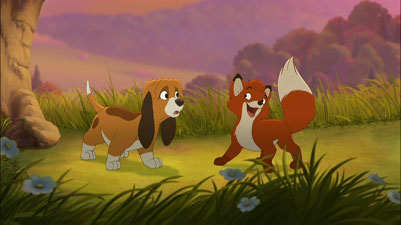
Not to pick a fight or anything, but I think this is as off-base as the MSM media's ever-popular meme of "CG features are collecting smaller grosses because of the animation glut."
Please note this animation studio [Pixar's] highest earning production to date was "Finding Nemo." And that every Pixar production that has followed this Andrew Stanton movie then went on to earn significantly less than the picture that preceded it...
Now I bring up this pattern because -- if you're familiar with your Walt Disney Animation Studios history -- there's actually a historical precedent for Pixar's current predicament ...
Mr. Hill goes on to show two amazing, roller-coaster type charts (Disney and Pixar -- could there be a connection?) The grosses of each go up (Toy Story, Nemo / Beauty and the Beast, Aladdin, Lion King) and the grosses of each go down (Incredibles, Cars, Ratatouille /Pocahontas, Hunchback of Notre Dame, Hercules).
Except for the Disney chart, where sometimes the grosses don't go down. (Tarzan, Mulan, Brother Bear etc.)
But Jim has a ready explanation, (not to mention a third chart). The pictures that broke the mold were different than the ones that went before, or done at another studio, or well...something.
One handy explanation is that Mulan and Brother Bear (not to mention Lilo and Stitch) were done in the Florida studio and the artists therein were further away from the horrid West Coast suits. Made all the difference.
Ah, message to Jim? Those suits? They flew into Orlando all the time. (There's an airport.) And they had lots of interaction with Orlando via media conferencing (it's now all the rage.)
Added to which, story work and animation were done on both coasts. In the case of Mulan, a huge amount of boarding was done in Burbank...and went on for years. And those Florida artists? A number of them were Burbank transplants.
(But Jim doesn't need me to tell him the roller coaster theory doesn't really hold up. He addresses the problem himself. By trying to grant himself exceptions.)
Here's the problem with easy, glib theorizing. It works until it doesn't. And the evidentiary graphs only work if you start them at the right place. (Like, there's no point in showing how The Rescuers and Fox and the Hound were big grossers for their time, way back in '77 and '81. It blows the neat down-up-down storyline because the two features that followed it (Black Cauldron, Great Mouse Detective) were relatively low grossers before the trend-line nosed up again.)
So here's my theory (or as Uncle Karl Rove might put it: "The theory").
Every feature film is filled with its unique strengths and weaknesses. Some audiences like some features better than others, so some features make more money than others.
And trend lines always revert to the mean. Until they don't.
It's like Sam Goldwyn, that legendary Hollywood wit, said: "When they don't want to come and see your movie, you can't stop them."




6 comments:
I would amend your theory to add:
Some films are released at a time when there is little to no competition allowing a film to develop legs or have a huge opening. Others are released in a glut of films (animated or otherwise) that force direct competition for audiences limited dollars and time.
Rat was hit hard not just by a difficult marketing job given its "is not Disney / is now Disney" history. It was also hit extremely hard, as I posted on JHM, by the largest summer blockbuster competition in history (every weekend a new release) driven entirely by sequels to well established franchises. This summer, Rat was the only *new* thing out there where everything else was a sequel or a reimagining of an existing property. That it held up as well as it did should be commended.
Finally, out of all those properties, they've all got limited futures. Only Transformers and Shrek are destined for a sequel (and *maybe* Pirates).
But Rat, being Disney, will never really ever go away. They'll find a home in the parks, a way into every home via dvd, and they'll continue to be watched intentionally while most of the others will just be "oh, well, it's on TNT right now and nothing else is on" which is the fate of many a Disney competitor.
And with a DVD tie-in, I can see Rats selling quite a bit of merchandise this holiday.
Jim Hill thinks like the executives he claims to dislike.
Only more shallow, if that's possible.
I can't for the life of me figure out why anyone bothers with Jim Hill. He's wrong far more often than he's right, and like this example shows he frequently cooks his "proof" to fit whatever preconceived notion he woke up with that morning.
Why would a site like this pay any attention to a scumbag like jim hill? He's not a reporter, a journalist, or even a good writer.
Call a spade a spade. jim hill is a liar.
I would amend your theory to add:
Some films are released at a time when there is little to no competition allowing a film to develop legs or have a huge opening. Others are released in a glut of films (animated or otherwise) that force direct competition for audiences limited dollars and time.
And I would amend Sam Goldwyn's "When they don't want to come to see your movie, you can't stop them... with:
"And the opposite."
Post a Comment